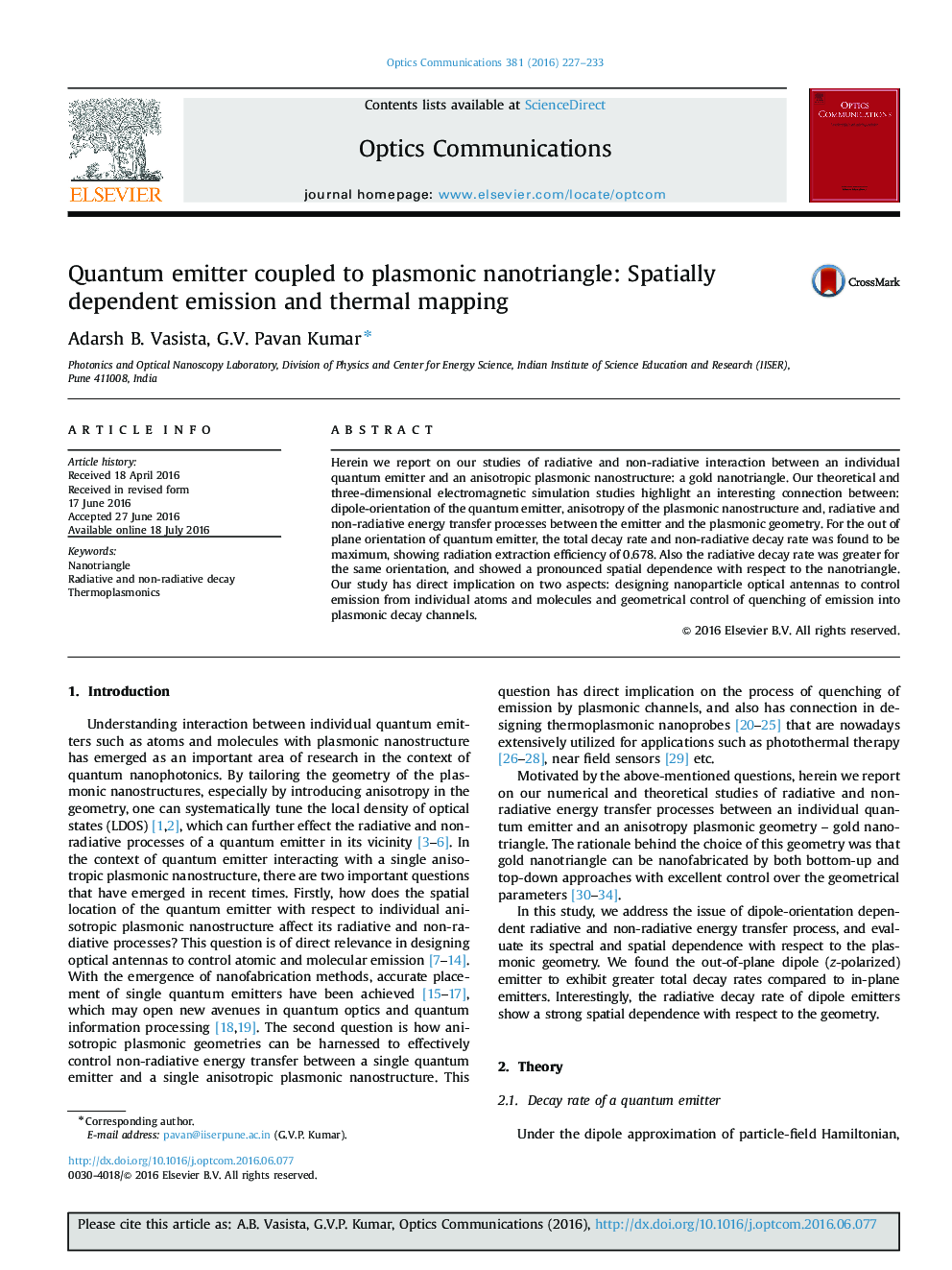| کد مقاله | کد نشریه | سال انتشار | مقاله انگلیسی | نسخه تمام متن |
|---|---|---|---|---|
| 1533027 | 1512542 | 2016 | 7 صفحه PDF | دانلود رایگان |
عنوان انگلیسی مقاله ISI
Quantum emitter coupled to plasmonic nanotriangle: Spatially dependent emission and thermal mapping
ترجمه فارسی عنوان
فرستنده کوانتومی همراه با نانو بیضوی پلاسمونی: انتشار فضایی و نقشه برداری حرارتی
دانلود مقاله + سفارش ترجمه
دانلود مقاله ISI انگلیسی
رایگان برای ایرانیان
ترجمه چکیده
در اینجا ما در مطالعات ما در مورد تعامل تابشی و غیر تابشی بین یک امیتر کوانتومی فردی و یک نانوساختار پلاسمونی ناحیه ای: یک نانوساختار طلا گزارش می دهیم. مطالعات شبیه سازی الکترومغناطیسی نظری و سه بعدی ما یک اتصال جالبی بین: جهت گیری دو قطبی از ناحیه کوانتومی، انحصاری از ساختار نانوساختار پلاسمونی و فرآیند انتقال انرژی شعله ای و غیر تابشی بین امیتر و هندسه پلاسمونی را نشان می دهد. برای خارج کردن جهت هواپیما از امیدهای کوانتومی، میزان کل تخریب و نرخ ناپایداری غیر تابشی بیشترین مقدار را نشان می دهد که بازده استخراج تابشی برابر با 0.678 است. همچنین میزان پوسیدگی تابشی برای جهت گیری مشابه بیشتر بود و نشانگر وابستگی فضایی مشخص نسبت به نوری است. مطالعه ما مستقیما به دو جنبه اشاره دارد: طراحی نانوذرات نوری برای آنتن های نوری برای کنترل انتشار از اتم ها و مولکول های فردی و کنترل هندسی رطوبت انتشار به کانال های پوسیدگی پلاسمونی.
موضوعات مرتبط
مهندسی و علوم پایه
مهندسی مواد
مواد الکترونیکی، نوری و مغناطیسی
چکیده انگلیسی
Herein we report on our studies of radiative and non-radiative interaction between an individual quantum emitter and an anisotropic plasmonic nanostructure: a gold nanotriangle. Our theoretical and three-dimensional electromagnetic simulation studies highlight an interesting connection between: dipole-orientation of the quantum emitter, anisotropy of the plasmonic nanostructure and, radiative and non-radiative energy transfer processes between the emitter and the plasmonic geometry. For the out of plane orientation of quantum emitter, the total decay rate and non-radiative decay rate was found to be maximum, showing radiation extraction efficiency of 0.678. Also the radiative decay rate was greater for the same orientation, and showed a pronounced spatial dependence with respect to the nanotriangle. Our study has direct implication on two aspects: designing nanoparticle optical antennas to control emission from individual atoms and molecules and geometrical control of quenching of emission into plasmonic decay channels.
ناشر
Database: Elsevier - ScienceDirect (ساینس دایرکت)
Journal: Optics Communications - Volume 381, 15 December 2016, Pages 227-233
Journal: Optics Communications - Volume 381, 15 December 2016, Pages 227-233
نویسندگان
Adarsh B. Vasista, G.V. Pavan Kumar,
